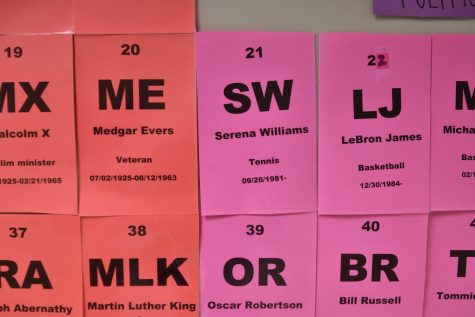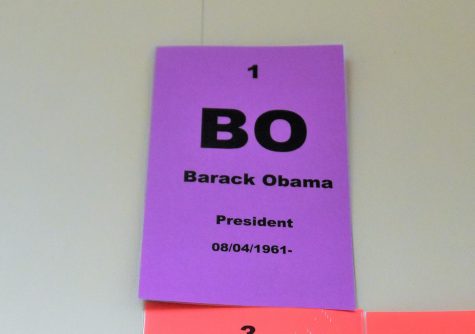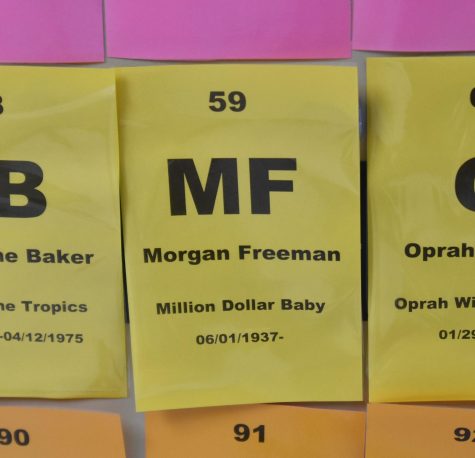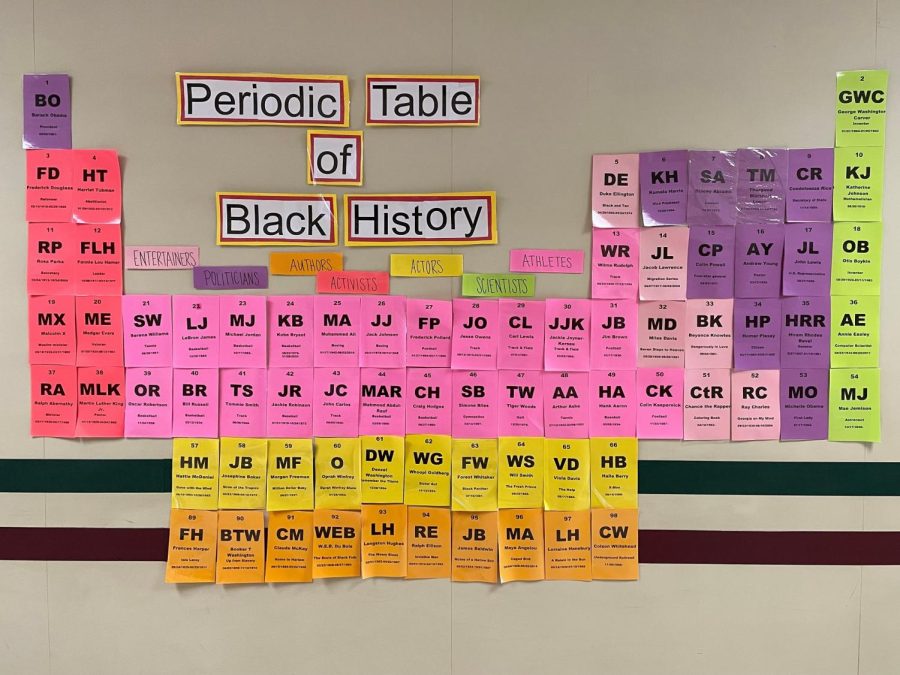A periodic view of Black History Month
Black History Month is an important time to recognize how African Americans have left their fingerprints on the framework of America.
CFHS Middle School teacher Rachel Langer posted an adaptation of the periodic table to reflect Black History Month
Martin Luther King Junior. Harriet Tubman. Rosa Parks. Barack Obama. Medgar Evers. These are just a few of the many African Americans who have made a significant impact on the country. Black people haven’t been appropriately recognized for what they have done, and will never be known for what they have accomplished. For centuries, African Americans have not been treated with respect because of the color of their skin. Schools across America teach students about black history, but some kids still don’t understand that black history is important and should be taught to everyone.
Before it became a month in 1970, the recognition of black history spanned the second week of February and was called Negro History Week. Negro History Week started in 1926, and it was created to focus more attention on black people who have contributed to the country. In modern times, Negro History Week has morphed into Black History Month, which is known and recognized by many, but twenty eight days are hardly enough to show the contributions of the black community. It honors Africans from the 17th century who were enslaved and brought to the US as well as black culture today.
One black history maker was Rosa Parks. She said no to a white man who told her to move seats on the bus since black people were instructed to sit in the back due to their skin color. Parks refused and sat in the front, eventually getting kicked off the bus and sent to jail. As a result, African Americans boycotted the bus, which meant less money for the industry that finally let them sit where they wanted, all because of Rosa Parks.
Cannon Falls, a tiny town in southeast Minnesota, is a rural community that doesn’t have a very diverse population in or outside of the school. Nonetheless, in the hallway of the High School/Middle School, there is a fine example of creativity posted up on the wall, and it involves black history. A periodic table was put up in honor of Black History Month and since Cannon Falls is made up of mostly white students, it teaches middle school students about black excellence, even when the examples come from far away. Not only that, through learning about black history in class, students have learned about a different layer of America’s past.
Rob Stachowski, the Global Studies teacher for eighth grade, and a US history teacher for seventh grade, was interviewed on his curriculum involving the African American community. “For what I teach in US History seventh grade, we go through a lot of leaders in black history during the Civil War, some prior to the Civil War, some after the Civil War. Everyone from Biddy Mason to Frederick Douglass. We cover a lot of those people on the struggle of the Civil Rights Movement in the 1950s and 60s as well. From my experience, most students come to my class and have heard about Martin Luther King Jr. and Harriet Tubman.” Stachowski’s goal is to teach students about more than just those two iconic fixtures, though “I think it’s important for students to know about black history because there’s so much that we never know about black history. For me, growing up in Minneapolis, there wasn’t really a huge focus on black history but there’s so many contributions to United States history from African Americans. You don’t want it to fall by the wayside and get forgotten. As a parent of an African American, I still see the struggle today.” As mentioned by Stachowski, racism still presents itself today in the hidden and not so hidden struggles of African Americans, which is especially important to focus on during Black History Month.
Rights Movement in the 1950s and 60s as well. From my experience, most students come to my class and have heard about Martin Luther King Jr. and Harriet Tubman.” Stachowski’s goal is to teach students about more than just those two iconic fixtures, though “I think it’s important for students to know about black history because there’s so much that we never know about black history. For me, growing up in Minneapolis, there wasn’t really a huge focus on black history but there’s so many contributions to United States history from African Americans. You don’t want it to fall by the wayside and get forgotten. As a parent of an African American, I still see the struggle today.” As mentioned by Stachowski, racism still presents itself today in the hidden and not so hidden struggles of African Americans, which is especially important to focus on during Black History Month.
Rachael Langer, a sixth grade science teacher, put up the display modeled after the periodic table. It’s filled with 74 famous black people. In an interview, Langer commented, “I set up the Periodic Table of Black History to bring attention to this month and what it celebrates. There are so many people from different backgrounds and times that have each impacted our world in a unique way. Drawing attention to these people is a small gesture to appreciate their hardships.” She went on to state that she hoped the students at the school would take some time to look at the people represented on the table. “I know a lot of different people of color. I am family, friends, acquaintances, colleagues, peers, and neighbors with them. I think that every single person has their own journey to travel.”
A sixth grade social studies teacher, Melissa Klapperich, was interviewed about her experiences with black history. When she was asked about what she teaches on the topic of Black History she said, “Throughout our social studies curriculum, there are a number of black Minnesotans who are very powerful, important, and did amazing things.” When asked about how she felt on Black History Month she responded with. “I think it’s really important.”
 Many African American people from now to 400 years ago have been recognized, and are still making their mark today. Barack Obama, the first black President of the United States, was in office for 8 years, and many thought he was a great man, not just because he made good decisions. He was and still is a role model for anybody, not just African Americans. Mae Jemison—the first black woman to be an astronaut—also makes an appearance on the periodic table of black history. Jemison is famous for writing multiple children’s books, and she has appeared on television several times.
Many African American people from now to 400 years ago have been recognized, and are still making their mark today. Barack Obama, the first black President of the United States, was in office for 8 years, and many thought he was a great man, not just because he made good decisions. He was and still is a role model for anybody, not just African Americans. Mae Jemison—the first black woman to be an astronaut—also makes an appearance on the periodic table of black history. Jemison is famous for writing multiple children’s books, and she has appeared on television several times.
While many famous African Americans motivate by playing an important part in country and world affairs, there are also those who made their mark through acting, singing, and athletics. Sisters Venus and Serena Williams are two famous tennis players, and recently had a movie created about their father raising them to be two of the greatest athletes in the world. Will Smith, a famous black actor, film producer, and rapper, starred as Richard Williams, their father, in the movie.
A famous track star, Wilma Rudolph, born in 1940, died in 1994, was an American sprinter. She participated in the 1956 and 1960 Olympic Games, and won three gold medals in Rome and Italy. She was said to be the fastest woman in the world. Kobe Bryant, a famous basketball player, died in 2020. A tragic helicopter crash killed Bryant and eight other people, including Bryant’s daughter, Gianna Bryant. Bryant was a basketball player loved by many people, and was an inspiration to the country. 
Morgan Freeman, a black actor, has been in several movies and television shows like Bruce Almighty (2003), The Nutcracker (2018), and A Journey Through American Music (2010-2011). An American producer and actress, Viola Davis, was the recipient of a Primetime Emmy Award, an Academy Award, and two Tony Awards. She’s the first African American to receive the “Triple Crown of Acting.”
The admirable achievements of African Americans deserve to be recognized, and their struggles are noteworthy, too. Black History Month should shine a light on every African American, not just those living in the public eye, but those who make their mark by leading ordinary lives.
While there were only 74 inspirational African Americans on the periodic table, there have been limitless African American inspirations throughout time. Today, these figures continue to inspire.

Hi everyone! I’m a sophomore and this year marks my fifth with the Lantern, and my second as an editor. I play volleyball and run track, and am also...

Marilyn is a weird chaotic human. She loves sweatshirts and her three dogs; she also has a demon cat. She's somewhat smart and quite shy. She has some...

Emilia Nelson, a mysterious young lady from Artemisia on the planet of Luna. The 3rd Trimester of the Plague broke through and she stole a ship and crashed...

Emilia Nelson, a mysterious young lady from Artemisia on the planet of Luna. The 3rd Trimester of the Plague broke through and she stole a ship and crashed...


